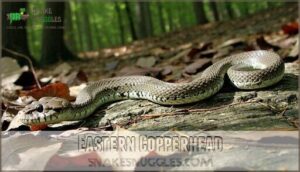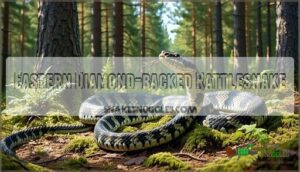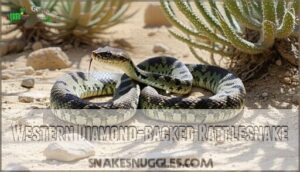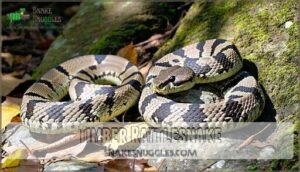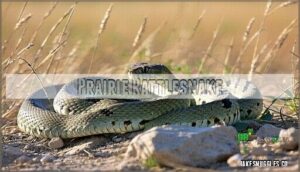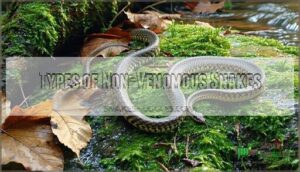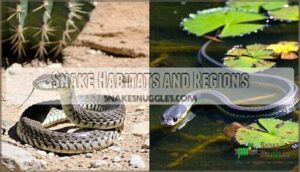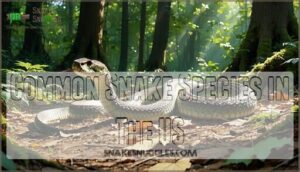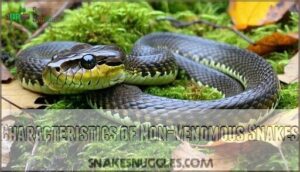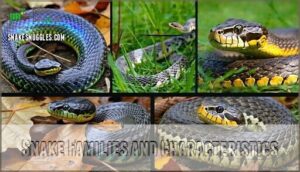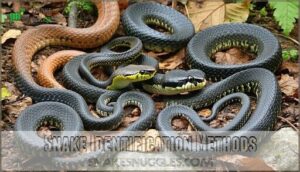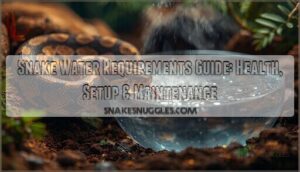This site is supported by our readers. We may earn a commission, at no cost to you, if you purchase through links.
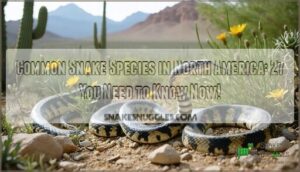 You’ll find diverse common snake species in North America ranging from harmless to venomous types.
You’ll find diverse common snake species in North America ranging from harmless to venomous types.
Garter snakes, with their distinctive stripes, are likely slithering in your garden. Rattlesnakes, copperheads, and cottonmouths make up the venomous crowd – you’ll want to recognize these on sight.
The black rat snake, a helpful rodent controller, can grow up to 6 feet long. In western regions, you might spot bullsnakes or kingsnakes keeping rodent populations in check.
Each species has adapted to specific habitats from deserts to forests. Knowing the difference between a harmless water snake and a dangerous cottonmouth could save you more than just peace of mind.
Table Of Contents
- Key Takeaways
- Types of Venomous Snakes
- Characteristics of Venomous Snakes
- Types of Non-Venomous Snakes
- Snake Habitats and Regions
- Common Snake Species in The US
- Characteristics of Non-Venomous Snakes
- Snake Families and Characteristics
- Snake Identification Methods
- Problems Caused by Snakes
- Snake Control and Removal
- Frequently Asked Questions (FAQs)
- How many types of snakes live in North America?
- How many venomous snakes are there in the United States?
- Where do snakes live in the United States?
- Are there venomous snakes in North America?
- What is the most common snake in the US?
- How many different types of snakes are there in North America?
- What are the 4 venomous snakes in the US?
- What is the most poisonous snake in North America?
- How do snakes survive in urban environments?
- What do snakes eat during winter months?
- Conclusion
Key Takeaways
Here are 4 key takeaways about common snake species in North America:
- You’ll find approximately 150 snake species across North America, with only 20-30 venomous species including rattlesnakes, copperheads, cottonmouths, and coral snakes that you should learn to identify by their triangular heads, vertical pupils, and distinctive patterns.
- You can identify non-venomous snakes by their round pupils, narrow heads, and absence of heat-sensing pits—they’re generally harmless to humans and help control pest populations like rodents and insects.
- You’ll encounter snakes in diverse habitats from deserts to forests, with each region shaping their behavior and physical traits—desert snakes have water conservation adaptations, forest snakes use bark-matching camouflage, and aquatic species have waterproof scales and specialized nostrils.
- You can prevent unwanted snake encounters by modifying your property through eliminating hiding spots, sealing foundation cracks, and installing mesh fencing—remember that most snakes avoid humans when possible and provide natural pest control.
Types of Venomous Snakes
You’ll find five potentially dangerous venomous snake species across North America, including the Eastern Copperhead with its distinctive hourglass pattern and various rattlesnakes equipped with warning rattles.
Knowing how to identify these serpents by their unique characteristics can help you stay safe during outdoor adventures, whether you’re hiking through the eastern woodlands where Timber Rattlesnakes lurk or exploring southwestern deserts where Diamond-backed species make their home.
Eastern Copperhead
The Eastern Copperhead’s distinctive hourglass-shaped bands make it stand out among venomous pit vipers.
These stout-bodied snakes reach 20-37 inches with broad heads and elliptical pupils.
They prefer rocky outcroppings in deciduous forests.
Their diet consists mainly of rodents, which they ambush using heat-sensing pits.
Though venomous, their bites rarely prove fatal due to relatively low venom potency.
They’re most active during daylight in spring and fall, switching to night hunting in summer.
Eastern Diamond-backed Rattlesnake
The Eastern Diamond-backed Rattlesnake reigns as North America’s largest venomous snake, reaching up to 8 feet long.
This formidable pit viper demands respect when encountered.
- Distinguished by diamond-shaped dorsal blotches with cream borders
- Prefers longleaf pine habitats across the southeastern U.S.
- Diamondback venom requires immediate medical treatment if bitten
- Conservation status vulnerable due to habitat loss
- Uses its iconic rattle as a warning before striking
Western Diamond-backed Rattlesnake
The Western Diamond-backed Rattlesnake stands out among venomous snakes with its iconic spade head and remarkable desert camouflage.
You’ll find these pit vipers throughout the southwestern United States, where they’ve mastered ambush predator techniques.
Despite their intimidating reputation, western diamondbacks maintain ecological balance by controlling rodent populations.
| Feature | Description | Function |
|---|---|---|
| Diagonal Stripes | Black bands from eyes to jaw | Species identification |
| Diamond Pattern | Light-colored with dark diamonds | Desert camouflage |
| Potent Venom | 10-20% untreated mortality | Prey capture & defense |
Their venom potency demands respect—proper snake identification saves lives when exploring their desert habitat, highlighting the importance of desert camouflage.
Timber Rattlesnake
Unlike its western cousin, the Timber Rattlesnake thrives in eastern hardwood forests and rocky slopes.
This heavy-bodied snake stretches 36-60 inches long with distinctive dark crossbands on a tan or pinkish-gray background.
You’ll often spot them basking on south-facing slopes or hunting along stone fences. When disturbed, they’ll warn you with their black-tipped rattle.
Four critical facts about Timber Rattlesnakes:
- They possess extremely toxic venom requiring immediate medical treatment
- They’re skilled tree climbers despite their size
- Their conservation status is threatened in many regions
- They help control rodent populations
Prairie Rattlesnake
The adaptability of the Prairie Rattlesnake makes it a survivor across western North America’s diverse landscapes.
You’ll find this venomous snake inhabiting prairies, wooded mountains, and even desert edges from Canada to Mexico.
With greenish-gray to light brown coloration and distinctive dark blotches, it’s camouflaged perfectly for hunting small mammals in its habitat range.
Its powerful venom combines hemotoxic and neurotoxic properties, requiring immediate medical attention if encountered.
Despite its fearsome reputation, this rattlesnake plays a pivotal role in maintaining ecosystem balance.
Conservation efforts aim to protect this species, currently listed as Least Concern with stable populations.
Their venom contains hemotoxins that destroy tissue, which is a key aspect of its venomous nature.
Characteristics of Venomous Snakes
When you encounter a snake in the wild, identifying venomous species could save your life.
Look for triangular heads, vertical pupils, and heat pits near the nostrils—hallmarks of pit vipers like rattlesnakes.
Venomous snakes typically have shorter, stockier bodies with more distinct neck regions, and their fang morphology varies, with some sporting folding fangs that deliver venom through specialized channels.
Most have a strike range of about half their body length, and venom composition differs between species: rattlesnakes use hemotoxins that destroy tissue, while coral snakes deploy neurotoxins affecting the nervous system.
Types of Non-Venomous Snakes
You’ll find that most snakes you encounter in North America are actually harmless, with species like the Northern Watersnake and Eastern Garter Snake making up the majority of backyard visitors.
These non-venomous snakes play vital roles in controlling rodent and insect populations, making them valuable allies in maintaining ecological balance rather than threats to fear, as they contribute to ecological balance.
Northern Watersnake
When you spot a Northern Watersnake gliding through water, you’re witnessing one of North America’s most common aquatic reptiles.
Though often mistaken for venomous species, these non-venomous snakes are harmless despite their defensive nature.
- Medium-sized (24-55 inches) with distinctive crossbands
- Prefers lakes, rivers, and quiet waters for hunting
- Feeds primarily on fish and amphibians
- Darkens with age, making identification challenging
- Plays a vital ecological role in aquatic ecosystems
Plain-bellied Watersnake
The Plain-bellied Watersnake glides through shallow water, its dark body contrasting with a distinctive yellow belly.
You’ll find this medium-sized, non-venomous snake near swamps, rivers, and ponds, though it often ventures onto dry land during summer.
While shy around humans, it defends itself through musking when threatened.
Their diet primarily consists of frogs, fish, and salamanders, making them essential to North American aquatic ecosystems.
Queen Snake
Along the rocky habitats of North American streams, the Queen Snake (Regina septemvittata) stands out with its olive-gray body and unique stripes. This nonvenomous snake specializes in a crayfish diet, preferring recently molted "soft" specimens.
- Active primarily during daylight hours from April through September
- Features four distinctive dark ventral stripes on its yellowish belly
- Rarely bites humans but may release musk when handled
- Conservation status: Least Concern, though stream ecology impacts populations
- Often confused with garter snakes due to similar appearance
The Queen Snake’s characteristics, including its unique stripes and feeding habits, distinguish it from other snakes. Its preference for recently molted crayfish highlights its specialized feeding behavior.
Southern Watersnake
Unlike the crayfish-loving Queen Snake, the Southern Watersnake thrives in freshwater habitats across the southeastern U.S.
You’ll recognize this non-venomous species by its dark brown body with lighter bands and distinctive reddish belly spots.
Though often mistaken for venomous cottonmouths, these stout-bodied snakes are harmless to humans.
Their nocturnal behavior centers around hunting frogs and fish, with an impressive reproductive capacity of 9-50 live young per season.
Diamond-backed Watersnake
The Diamond-backed Watersnake’s distinctive pattern makes it a regular sight in freshwater habitats across the central U.S.
You’ll find this non-venomous species near slow-moving waters with overhanging vegetation.
They’re skilled hunters, using a unique grab-and-haul method to catch fish and frogs.
Despite their aggressive defensive behavior when cornered, they’re harmless to humans—though often mistaken for venomous cottonmouths due to their stocky build and keeled scales.
Snake Habitats and Regions
You’ll find North American snakes thriving in four distinct habitat types: arid deserts, dense forests, open grasslands, and freshwater environments.
Each region shapes snake behavior and physical traits, with species like the Western Diamond-backed Rattlesnake dominating desert landscapes while Watersnakes claim aquatic territories.
Desert Regions
While non-venomous snakes thrive in moist environments, desert snakes have evolved remarkable adaptations to survive harsh conditions.
You’ll find smaller, lighter-colored species like pit vipers perfectly suited for arid landscapes.
Desert snakes excel at water conservation and temperature regulation through behavioral changes and specialized scales.
Their camouflage techniques help them blend into sandy surroundings, while efficient hunting strategies optimize their limited energy.
For protection, consider using desert snake repellents.
North American desert species include the Mojave rattlesnake, known for its potent venom.
Forest Regions
Forest regions offer North American snakes the perfect habitat with abundant cover from trees, logs, and leaf litter.
You’ll find species like timber rattlesnakes and copperheads adapting brilliantly with forest camouflage patterns matching bark and fallen leaves.
Forest snake diets primarily consist of rodents, amphibians, and insects—nature’s pest control at work.
These slithering residents face forest snake threats including habitat loss and fragmentation, making forest snake conservation increasingly important for maintaining healthy woodland ecosystems.
Temperate deciduous forests influence snake behaviors, including hibernation.
Grasslands
While forests offer dense shelter, grasslands provide open hunting grounds where native snake species thrive.
You’ll find several grassland snakes like pit vipers adapting to these wide-open spaces. They’ve developed expert camouflage techniques, blending perfectly with tall grasses and soil.
These areas offer abundant prey—rodents, insects, and small mammals—supporting diverse snake behavior. Many species show increased seasonal activity during warmer months when prey is plentiful.
Making conservation efforts essential for these important ecosystem regulators, to protect these habitats, consider using snake repellent options. They are crucial for maintaining the delicate balance of the ecosystem.
Aquatic Regions
While grasslands house their own snake varieties, aquatic regions reveal a completely different serpent world.
In North America, you’ll find specialized water snakes thriving in swamp habitats, river ecosystems, and coastal areas.
Water snakes have remarkable adaptations – waterproof scales, specialized nostrils, and powerful swimming muscles.
Species like the Northern Watersnake and Diamond-backed Watersnake dominate wetland areas, hunting fish and amphibians.
For proper snake identification, look for their streamlined bodies and upward-facing eyes – features that help them navigate and hunt effectively in aquatic environments.
Common Snake Species in The US
You’ll find a fascinating variety of snakes across the U.S., from harmless garden dwellers to powerful predators.
Understanding their unique traits helps you appreciate their role in ecosystems while staying safe.
Eastern Garter Snake
The Eastern Garter Snake is one of the most common snakes you’ll spot in North America.
Found in city parks, grassy backyards, and near freshwater, it’s easily recognized by its signature stripes.
Its diet includes worms, amphibians, and small fish, making it a valuable pest controller.
Known for its calm behavior, it defends by releasing musk when threatened.
This adaptable species contributes to its ecosystem’s balance. Protecting its habitat guarantees these fascinating creatures remain a key part of North American snakes.
Red-sided Garter Snake
When spotting a red-sided garter snake, look for its stunning color variations—three yellow stripes, red or orange side markings, and a dark green to black background.
These North American snakes thrive in moist habitats near water, and they’re big fans of amphibians and small critters.
Snake identification is a breeze with their bold patterns!
Curious about their reproduction habits? They lay eggs, keeping things simple.
Conservation efforts focus on protecting their wetland habitats, ensuring these remarkable snake species continue adding beauty to diverse snake habitats, which is crucial for their conservation.
Western Ribbon Snake
By the water’s edge, the Western ribbon snake glides with its slim body and sleek tail—like nature’s own ribbon dancer.
This nonvenomous snake thrives in wetlands, ponds, and streams, embodying the charm of snake species in North American snakes.
Its Ribbon Snake Diet includes small amphibians and fish, making it a key part of aquatic ecosystems.
Keep an eye out for snake identification clues in its slender form.
Supporting Ribbon Snake Conservation helps protect these graceful, beneficial creatures.
Eastern Ribbon Snake
The Eastern Ribbon Snake is a graceful swimmer among North American snakes, often spotted near wetlands and ponds.
Its slender body and swift movements make it a standout in any snake identification guide.
This garter snake thrives on a Ribbon Snake Diet of frogs and small fish, blending effortlessly into its Ribbon Snake Habitat.
Conservation efforts aim to protect its delicate wetlands, ensuring future generations enjoy this fascinating species’ Ribbon Snake Behavior.
Characteristics of Non-Venomous Snakes
You’ll find non-venomous snakes are easily recognized by their round pupils, narrow heads, and absence of heat-sensing pits.
They’re harmless to humans and play a key role in controlling pests like rodents and insects.
Black Racer
The Black Racer, one of North America’s swiftest nonvenomous snakes, zips through forests and fields with incredible agility.
Known for its slender, shiny black body, it’s an expert hunter.
Here’s what you should know:
- Speed: This snake’s speed helps escape predators.
- Diet: Feeds on small mammals, birds, and reptiles.
- Habitat: Adapts well to forests, grasslands, and farmlands.
Blackneck Garter Snake
This sleek garter snake stands out with its striking black-striped neck and calm demeanor.
Found across North America in forests, wetlands, and grasslands, its Blackneck Habitat is diverse.
Its Blackneck Diet includes amphibians, fish, and invertebrates.
Known for its gentle behavior, it’s a harmless species.
Thanks to healthy populations, Blackneck Conservation status isn’t a concern today.
Blue Racer
When hearing about nonvenomous snake species like the Blue Racer, you might picture sleek speed.
These snakes are true sprinters of North America, darting through grasslands with agility that’ll leave you amazed.
Blue, gray, and sometimes greenish hues give them their stunning looks, making them stand out in snake identification guides.
Their habitats include open fields, prairies, and forest edges.
Their diet? Small mammals, birds, and insects.
Though quick-tempered, they’re harmless to humans.
Respect their presence—they’re essential players in Racer conservation and nature’s delicate balance, letting them sizzle through life undisturbed, which is crucial for maintaining the delicate balance.
Corn Snake
Meet the Corn Snake, one of North America’s most cherished non-venomous snake species! Known for their chill temperament, they’re often the first choice for beginner snake enthusiasts.
Their vibrant snake patterns and colors, known as Corn Snake Morphs, range from fiery reds to soft oranges. Add their easy Captive Care and a rodent-focused Corn Snake Diet, and you’ve got a stellar snake companion.
- Habitat Needs: Warm enclosures with hides.
- Breeding Corns: Controlled temps and lighting.
- Snake Coloration: Naturally stunning, minimal upkeep.
Snake Families and Characteristics
In understanding snakes, recognizing the distinct traits of their families is key.
From the burrowing Slender Blind Snakes to the massive Boidae and adaptable Colubrids, each group brings unique features to the table.
Slender Blind Snakes
Slender blind snakes, with their underground lifestyle, are fascinating reminders of evolutionary history.
They burrow through soil with ease, thanks to their vestigial limbs and single lung. Feeding on tiny invertebrates, they thrive across various habitats.
Let’s explore their world:
| Feature | Details | Fun Fact |
|---|---|---|
| Habitat Preferences | Underground burrows | Spends life hidden from view |
| Diet and Nutrition | Eats ants, termites | Loves larval insects |
| Conservation Status | Stable | Rarely encounters predators |
Boidae Family
The Boidae family showcases a blend of ancient instincts and modern adaptability.
Known for their strength and stealth, boas and pythons command attention across North America’s habitats.
Boa constrictors, with flexible jaws and formidable grip, rely on constricting prey in forests and grasslands.
Supporting Boidae conservation guarantees these remarkable snake species remain part of nature’s story rather than just a page in history books.
Colubrid Snakes
With over 2,000 species, colubrid snakes dominate North America’s snake diversity.
From garter snakes to rat snakes, they thrive in varied habitats, showcasing adaptable behavior. Their diets are just as diverse, including insects, small mammals, and even other snakes.
These mid-sized serpents lack a pelvic girdle but play big ecological roles. Protecting colubrid snakes guarantees balance, so let’s champion their conservation for future generations and ecosystems alike.
Snake Identification Methods
You can identify snakes by observing their body patterns, head shape, coloration, and scales.
Paying attention to these features helps you distinguish between harmless species and those that might be dangerous.
Body Patterns
Snakes’ body patterns are like Mother Nature’s artwork, blending science with survival.
These patterns—spots, stripes, and bands—are perfect for snake camouflage. They break up outlines, helping snakes vanish into forests, deserts, or grasslands. Some even mimic the look of venomous species for protection.
Here’s how patterns play a role:
- Disruptive patterns: Conceal their shape from predators (and you).
- Regional differences: Uniquely adapted to local habitats.
- Color variation: Even within one species, patterns shift.
- Pattern mimicry: Like impersonators, they scare off threats.
Recognizing these traits sharpens your snake identification skills!
Head Shape
If you’re face-to-face with a snake, take a closer look at its head! A triangular head, often paired with elliptical pupils, suggests a venomous snake, like rattlesnakes.
Rounded or flat heads? Likely non-venomous.
Check this quick guide:
| Head Shape | Example Species | Venomous? |
|---|---|---|
| Triangular | Eastern Copperhead | Yes |
| Spade-Shaped | Western Diamondback | Yes |
| Rounded | Northern Watersnake | No |
Head shape isn’t enough—combine clues wisely!
Coloration
Coloration tells you much about North America’s snake species.
Camouflage patterns let them melt into forests or deserts, hiding from predators. Some boast scale iridescence, flashing colors that dazzle in sunlight.
Aposematism warns enemies to back off, while melanism or albinism creates rare, striking appearances.
These color variations aren’t just beautiful—they’re survival tools that shape each snake’s story. Some green snakes use camouflage for survival, showcasing the importance of camouflage.
Scales
Gliding your finger over a snake’s surface reveals essential identification clues.
Scale morphology varies dramatically across North American species—from smooth, glossy scales on racers to keeled, ridge-like patterns on watersnakes.
Each scale type serves specific functions: protection, water retention, and locomotion.
You’ll notice differences in size, shape, and arrangement that evolved for different habitats.
When identifying snakes, examine these distinctive scale patterns alongside color and head shape for accurate species determination.
Problems Caused by Snakes
You’ll face three main problems with snakes on your property: venomous bites requiring medical attention, structural damage from nesting in buildings, and psychological distress for family members who fear these reptiles.
Despite their important ecological role, understanding these issues helps you manage snake encounters safely and effectively.
Venomous Bites
When you encounter a venomous snake on the trail, knowing the following signs can save your life:
Stay calm, spot swelling or discoloration, and seek medical care—timely action turns a venomous snake encounter into a survivable story.
- Intense burning pain and rapid swelling at the bite site from pit vipers like rattlesnakes
- Dizziness, nausea, and blurred vision indicating venom circulation
- Tissue discoloration and difficulty breathing in severe cases
Stay calm, immobilize the area, and seek medical care immediately.
Antivenom treatment substantially improves outcomes when administered promptly by professionals. Factors can influence antivenom treatment expenses.
Property Damage
While venomous bites get attention, snakes can cause unexpected property damage too.
These reptiles may damage your foundation when burrowing underneath structures or chew through electrical wiring in attics.
In gardens, they can disrupt plant roots and irrigation systems.
For effective snake control, install snake deterrents like mesh fencing around your property’s perimeter and seal entry points to prevent infrastructure impact and water contamination issues, which can be mitigated with effective snake control and by using mesh fencing.
Fear and Anxiety
Fear of snakes ranks among America’s most common phobias, often amplified by media influence and snake folklore. Understanding your encounter anxiety can help establish peaceful coexistence strategies.
- Snake phobias typically stem from misconceptions about bite risks rather than actual dangers
- Most snake bite incidents occur when humans attempt to handle or kill snakes
- Simple prevention techniques reduce bite risks by 90% when implemented correctly
You don’t need constant worry about snakes – with accurate information, you can appreciate these remarkable creatures from a respectful distance, and understand that snake folklore is not always a true representation of the risks involved.
Snake Control and Removal
Occasionally, homeowners face unwanted snake visitors, requiring effective control strategies. For successful snake prevention, focus on habitat modification by eliminating hiding spots—clear debris piles, trim tall grass, and remove woodpiles near your home. Seal foundation cracks and install mesh fencing for additional protection.
Various snake repellents exist, from commercial products to home remedies like sulfur or cinnamon oil, though effectiveness varies. For active removal, snake traps offer a humane option when properly placed along walls or known travel paths.
Before attempting DIY removal, research your local species—misidentification can be dangerous. Legal considerations may protect certain snake species in your area, making safe relocation the required approach.
To guarantee personal safety, always consider using protective gear like thick gloves and snake-proof boots. When in doubt, contact experts for professional trapping. They’ll safely remove the snake and advise on preventing future visits.
Remember, snakes often provide natural pest control for rodents, so peaceful coexistence through prevention is often the wisest approach.
Frequently Asked Questions (FAQs)
How many types of snakes live in North America?
Approximately 150 species of snakes call North America home.
You’ll find them in various habitats from Texas (with 68 species) to Alaska (with none).
Most are harmless, making your outdoor adventures safer than you’d think.
How many venomous snakes are there in the United States?
You’ll find between 20-30 venomous snake species in the United States, with four main types you should know: rattlesnakes, copperheads, cottonmouths, and coral snakes.
They’re widespread but rarely fatal if treated promptly.
Where do snakes live in the United States?
Snakes inhabit every U.S. state except Alaska, thriving in diverse habitats from deserts to forests.
You’ll find them near water sources, rocky outcroppings, woodlands, grasslands, and sometimes even in your backyard.
Are there venomous snakes in North America?
Like silent shadows lurking in the wild, venomous snakes do exist in North America.
You’ll find rattlesnakes, copperheads, cottonmouths, and coral snakes throughout various regions, each with their own distinctive markings and habitats.
What is the most common snake in the US?
The Eastern Garter Snake is considered the most common snake in the US. You’ll often find these harmless reptiles in your backyard, parks, or near water sources across most states.
How many different types of snakes are there in North America?
Our slithery friends number approximately 50 species across North America. You’ll find around 20 venomous varieties among them, while the other 30 non-venomous types pose no threat to your outdoor adventures.
What are the 4 venomous snakes in the US?
You’ll need to watch for four dangerous families in the US: rattlesnakes, copperheads, cottonmouths, and coral snakes.
They’re found across different regions and each has distinct markings you’d want to recognize, especially the distinct markings.
What is the most poisonous snake in North America?
The Mojave rattlesnake is considered North America’s most poisonous snake.
You’ll recognize it by its light bands on darker background.
Its potent neurotoxic venom makes it particularly dangerous if you’re unfortunate enough to encounter one.
How do snakes survive in urban environments?
Like shadows in concrete jungles, snakes adapt to urban life by utilizing storm drains, gardens, and abandoned lots.
You’ll find them hunting rodents, seeking shelter in building foundations, and warming themselves on sun-soaked pavements.
What do snakes eat during winter months?
Most snakes don’t eat during winter as they brumate (similar to hibernation).
They’ll slow their metabolism dramatically, conserve energy, and live off fat reserves until spring arrives when they resume hunting.
Conclusion
With over 50 species of common snake species in North America, your outdoor adventures require knowledge and preparation.
By learning to identify these serpents—whether the harmless garter snake or the venomous cottonmouth—you’ll navigate nature more confidently.
Remember, most snakes avoid humans when possible and play vital ecological roles.
Keep a safe distance, watch where you step, and appreciate these fascinating reptiles from afar, which is crucial for their conservation and your safety.
Your newfound snake awareness guarantees both your safety and their conservation.

